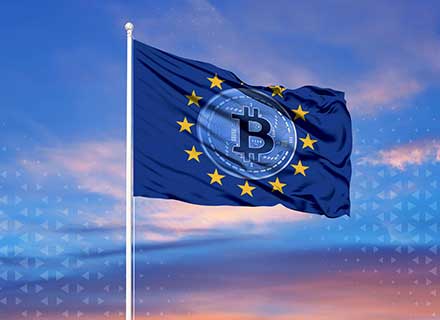The world’s first complete set of laws to govern the cryptocurrency sector received final approval from the European Union, adding pressure on nations like the United Kingdom and the United States to catch up.
Regulations were hammered out with the European Parliament and passed in April 2023. The European Union’s finance ministers met in Brussels to ratify the guidelines. The rules will go into effect in 2024.
Why Frame These Laws Now?
According to Chainalysis, the central, northern, and western parts of Europe received USD 1.3 trillion worth of crypto assets, accounting for around 22% of the crypto business. In addition to harmonizing the cryptocurrency business across 27 European nations, the MiCA framework gives the EU a competitive edge over the US or the UK, which lack legal certainty for the sector’s growth.
The collapse of the crypto exchange FTX in 2022, and the breakdown of the Terra Luna currency and its accompanying stablecoin, were just two of the most significant disasters and wipeouts in the crypto sector in 2022. These shocks’ lack of liquidity forced other cryptocurrency firms to cease consumer transfers and withdrawals before declaring insolvency.
Global regulators have recognized the need to introduce governance principles in crypto enterprises to preserve stability, as the scale of the crypto industry grows bigger. According to Stefan Berger, the MiCA regulation’s primary author in the European Parliament, the measure will shield consumers from fraud and deception, apart from helping the sector to rebuild its trust.
Which Assets Will MiCA Protect?
The text of the MiCA legislation broadly defines “crypto assets” as “a digital representation of a value or a right that uses cryptography for security and is in the form of a coin, a token, or any other digital medium that may be transferred and stored electronically, using distributed ledger technology or similar technology,” and states that these assets will fall under its purview. This definition indicates that it will apply to more recent cryptocurrencies like stablecoins and more established ones like Bitcoin and Ethereum.
Stablecoins seek to maintain a fixed exchange rate with a more reliable asset, such as the US dollar, a fiat currency, or another stable cryptocurrency. Three categories of stablecoins, asset-referenced tokens linked to various currencies, commodities, or cryptocurrencies, and e-money, will be subject to new regulations set forth by MiCA. There are two types of tokens: currency-linked and utility tokens, designed to grant access to a good or service that the token’s issuer will provide.
Regarding the assets that fall outside MiCA’s purview, it won’t control digital assets that would be considered transferable securities and behave similarly to shares or their equivalents, as well as other crypto assets that currently meet the criteria for being considered financial instruments under current law. It will also largely omit non-fungible tokens (NFTs).
MiCA will also not control the national central banks of EU member nations that issue digital assets in their position as a monetary authority.
Knowing The New Regulations
The base regime will require every CASP to register as a legal entity in the EU. After that, they can obtain authorization in 27 member states and provide services there. Following that, regulatory organizations will keep an eye on the businesses to make sure they have established suitable risk management and corporate governance protocols. The ability to protect users of the funds, implement controls to guarantee they are not participating in proprietary trading, prevent conflicts of interest, and mount a defence against market abuse and manipulation are all qualities CASPs will need to prove.
Service providers of stablecoins are also required to provide essential details in the form of a white paper that includes information about the cryptocurrency product and the company’s key players, the conditions of their public offer, the kind of blockchain verification mechanism they employ, the rights associated with the relevant crypto assets, the main risks involved for investors, and a summary to assist prospective buyers in making an informed decision.
To prevent liquidity crises, stablecoin issuers must keep enough reserves equivalent to their worth. In addition, the daily transaction volume for those stablecoin companies tied to non-euro currencies must not exceed €200 million (USD 220 million) in a given region.
To prevent money laundering and financing terrorism, another law established with the MiCA mandates that cryptocurrency companies provide their local anti-money laundering authorities with information about the senders and recipients of crypto assets.
The Response
The consensus is that having a regulatory framework is preferable to having no regulations and attracting regulatory action on a case-by-case basis without clarity. However, leaders at several of the largest Bitcoin firms have objected to certain features of MiCA.
Some experts also believe the law needs to catch up fast, in terms of addressing the recent weaknesses in the cryptocurrency sector. For instance, it excludes activities like crypto staking and lending, which were responsible for some of the worst failures in the industry in 2022. In addition, according to a Bloomberg investigation, MiCA does not cover NFTs or decentralized finance, which are vulnerable to fraud and hacking.
Although there is no defined deadline, Britain has detailed a staged strategy that would start with stablecoins and eventually include unbacked crypto assets.
While considering whether to adopt specialized new laws and who would apply them, the United States has concentrated on using existing securities rules for enforcement action in the industry.
Several federal and state agencies are attempting to determine what supervision role they could play in the cryptocurrency industry, according to Hester Peirce, a commissioner of the American derivatives regulator CFTC.
Conclusion
While the MiCA regulations are a significant step forward in regulating crypto assets, apart from providing legal certainty for the industry and protecting consumers from fraud and deception, these laws still have shortcomings and at the same point, need to be future-proof as well.


